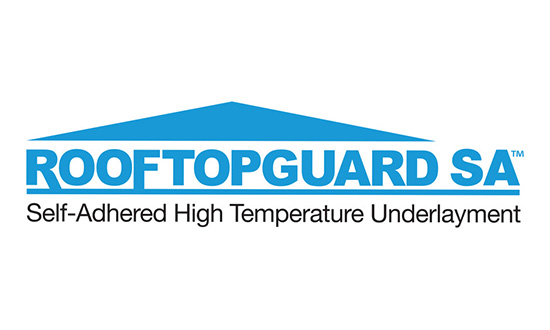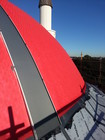- 267-263-2308
- info@uspunderlayment.com
RoofTopGuard SA Installation
RoofTopGuard SA is an air, water and vapor barrier and therefore must be installed above a properly ventilated space(s). Follow ALL building codes applicable to your geographical region and structure type as it is considered a vapor barrier.
STORAGE:
RTG SA should be stored at room temperature in a dry properly ventilated area. Keep clear from open flames, sparks, harmful substances and shelter from the elements.
Only rolls destined for same-day use should be removed from its storage area.
For best results store in temperatures between 32°F (0°C) and 90°F (32°C) If room temperature storage is not available, it is recommended to heat material to a minimum temperature of 15°F (-9.4°C) prior to application.
USE:
RTG SA must be covered by primary roofing within 180 days of application. RTG SA is designed for use under; Asphalt Shingles, Synthetic Shingles, Metal Roofing, Tiles, Slate, and Cedar Shakes.
DECK PREPARATION:
Protrusions from the deck area must be removed and decks shall have no voids, damaged or unsupported areas. Deck surface should be free of debris, dry and moisture free.
RTG SA may be applied directly to a plywood, OSB, concrete or masonry roof surface and should be fully covered as soon as possible or within 180 days. Priming is not required for attaching to wood surfaces when the temperature is above 15°F. Concrete and masonry decks should be primed with a solvent or a water based primer that meets ASTM D41 for asphalt based self-adhesive membranes.
For re-roofing projects replace any water damaged sheathing and sweep roof deck thoroughly removing dust, dirt and loose nails. Do not install over old roof covering.
Use of calcium or salt for ice and snow removal is not recommended.
APPLICATION:
For best results RTG SA should be installed on a dry deck when the air, membrane, and substrate temperature is over 15°F (-9.4°C).
For steep slope applications (6:12 or greater) or when installing at temperatures greater than 100°F (38°C) it is recommended to blind nail the overlap area as instructed
RTG SA is to be laid out horizontally (parallel) to the eave with the printed side up, using 5” selvage edge and 6” vertical laps.
RTG SA may also be installed vertically. For vertical installation anchor with 3/8” head roofing nails along the upper most edge 3 inches down with 6 equally spaced nails across the 59” width. Ensure roofing nails are perpendicular to the roof deck so that the head lays flat and seals well to the top surface of the RTG SA. Vertical overlaps to be 6” and 3” for horizontal laps if required.
Always work from the low point to the high point of the roof. Apply the membrane in valleys before the membrane is applied to the eaves.
Cut the membrane into manageable lengths. Peel back 1-2 feet of release liner, align the membrane, and continue to peel the release liner from the membrane. Hand press or walk on, then follow with a 40 lb or heavier pressure roller to smooth and secure the membrane, especially at the overlap layers. If a roller is not available or considered safe, walk on all laps, and as much of the field area as possible to push the adhesive into the pours of the roof deck and overlap.
For eave installation RTG SA should be applied over the metal drip edge at the eave. Do not fold RTG SA over the roof edge unless the edge is subsequently covered over by a drip edge or other flashing material. It is recommended that RTG SA extend from the eave up the roof to a point 48” inside the exterior wall. This should be above the maximum ice dam buildup line in most areas. Consult your local building code for specific requirements.
For valleys and ridge applications, peel the release liner; center the sheet over the valley or ridge, drape, and hand press in place. Note: It is very important RTG SA stay in contact with the roof deck into and out of the valley area. RTG SA should never be suspended or bridge a valley. It is recommended to follow up with a pressure roller or by walking on the surface. Give special attention to ALL perimeter edge areas.
Repair holes, fish mouths, tears, and any other penetration damage to the membrane with a round patch of membrane extending passed the damaged area by 6” in all directions. If fasteners are removed leaving holes in the membrane or other penetrations are accidentally produced, they must also be patched.
Do not install fasteners through membrane over any unsupported areas of the structural deck, such as over joints between adjacent structural panels.
For high elevation, high wind or wind driven rain it is recommended to cover the entire roof deck with RTG SA.
PRECAUTIONS:
RTG SA is not designed for indefinite outdoor exposure. Final roofing should be installed within 180 days of installation.
Depending on roof pitch and surface conditions, blocking maybe required to support roofing materials placed on the roof. Remember to seal the fastener holes that secured the blocking after they have been removed.
Protect completed roof areas to avoid damage during roof installation and material transportation by installing protective boardwalks to enable passage of people, equipment and products
Be careful not to load too much material on the roof deck in one area. Disburse the weight over structural supports where possible.
CAUTION - READ GOOD SAFETY PRACTICES BELOW
As with any roofing product, always follow safe roofing codes & practices (OSHA) and always use and wear fall protection devices when working on roofs. Release liners are slippery and should be removed from work area immediately after application. Use caution when walking or standing on RTG SA as slip resistance may vary with surface conditions, weather, footwear and roof pitch. Failure to use proper safety gear and footwear can result in serious injury.





